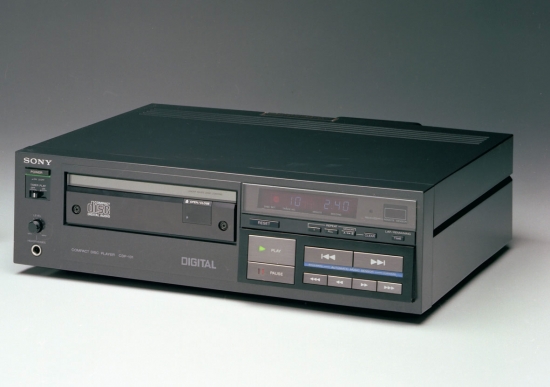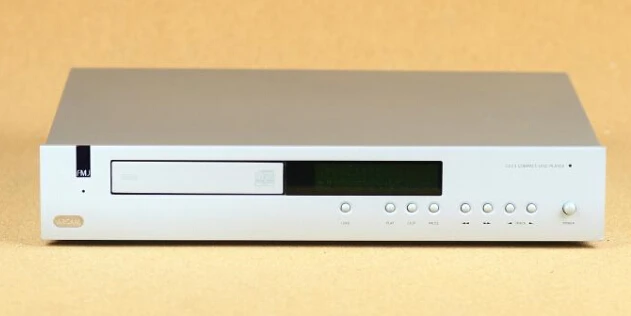This machine has recently received a lot of attention, and it is quickly becoming collectible. Of course, it has every right to be, as the world’s first commercially available CD player and not only Sony Corporation’s first silver disc spinner. It was first released on October 1, 1982, at a cost of Y168,000, but only reached the UK market in March 1983, at a cost of £800. Because Sony’s partner failed to reach the October ’82 target, Sony postponed the international launch of the CD, reflecting the fact that it was a joint Sony and Philips technology.
Despite the fact that the two machines shared a lot of silicon, it was intriguingly different from Philips’ first machine, the CD100. The disc tray loader was the highlight of the machine, a gorgeous assembly precision built from aluminium – unlike the plastic drawers used by later machines. The Philips CD100, on the other hand, had a top loading ‘drop in’ design that was more akin to traditional analogue turntables. Even though it’s now commonplace, the Sony’s drawer loading method appeared impossible to imagine in the UK in Spring 1983.
The digital vacuum fluorescent display that showed track number and playing time accompanied this ‘surprise and delight’ function; again, this was amazing stuff when compared to the Philips CD100’s cheap row of LEDs. When you add in track access times that made its Philips rival look sluggish and a full infrared RM-101 remote control, the Sony presented a fresh, hi-tech face to the outer world that contrasted sharply with the Philips’ clumsy and quirky design. In some ways, the Sony appeared to be a follow-up to Philips’ first-generation machine.
Unfortunately, many CDP-101s were destroyed due to the controller chips malfunctioning, locking the disc in the machine – or out, as the case may be – and this is not an easy remedy. It’s worth noting if you come across a 101 at a discount; if there’s any hesitation when opening or closing the drawer, brace yourself for quiet!
Oddly, the CDP-101 uses a single DAC chip shared between the left and right channels, and there’s no delay in one channel to ensure the signal arrives at the analogue output stage at the same time as the other, so you can hear odd ‘phasing’ effects on certain types of music, especially program material with heavy use of ride cymbals, for example, as one track arrives 11 seconds later. It’s definitely audible, and it’s strange that no one noticed it at the time…
The Sony has a 16-bit DAC board, whereas the Philips TDA1540 has a 14-bit DAC that is four times oversampled. Because the latter produced outstanding sound, it’s likely that Sony chose their own 16-bit system in the CDP-101 for marketing reasons rather than performance. Digital-to-analogue conversion is handled by a variety of Sony chips, including the CX-7933, CX-7934, CX-7935, and CX-20017, and a look inside reveals how crammed the midi-sized computer is. So much so that the mains transformer, as well as a big heatsink, are positioned outside the chassis.
The Sony is a joy to operate, with relay-controlled, metallized touch-sensitive transport controls and that swish, chunky disc tray. Even the plastic cover appears to be better than it is, and the machine feels quite unique; a fully functional model, for example, gives away very little to the later (and exquisite) ES machines. Using a first-generation Philips machine seems like you’ve stepped back in time to the 1970s rather than the 1980s!
It’s a funny one acoustically. The aforementioned time-smearing is a problem with certain, but not all, music, and it doesn’t help with soundstaging. In fact, it looks more like a vinyl record played by a poor moving magnet cartridge than most CD spinners, with a large, fat center picture but minimal image placement accuracy. It’s a great effect, but it’s not accurate. Some devices appear to have a better tone than others. Extensive listening reveals that the players are variable; perhaps a running change on the main board or a component swap explains why some sound plodding and matter-of-fact, while others are tremendously energetic and musical, with a particularly powerful bass. I’ve owned six CDP-101s over the years (and thrown away just as many), and there are two distinct ‘types’: one you’ll want to listen to, and the other you won’t.
The Sony CDP-101 is a sweet machine that is quirky by Sony standards, but it is more variable than most as a second-hand prospect. It gets heated, which causes some electrolytic capacitors inside to degrade faster than expected, plus there are drawer controller issues and strange sonic unpredictability. You’d want to own one these days more for the sake of completeness in a collection than for the sake of sound quality. The wackier Philips CD100 is a better performer, and it now has a more ‘sci-fi’ appearance. Depending on the quality and provenance, expect to pay between £50 and £250.







